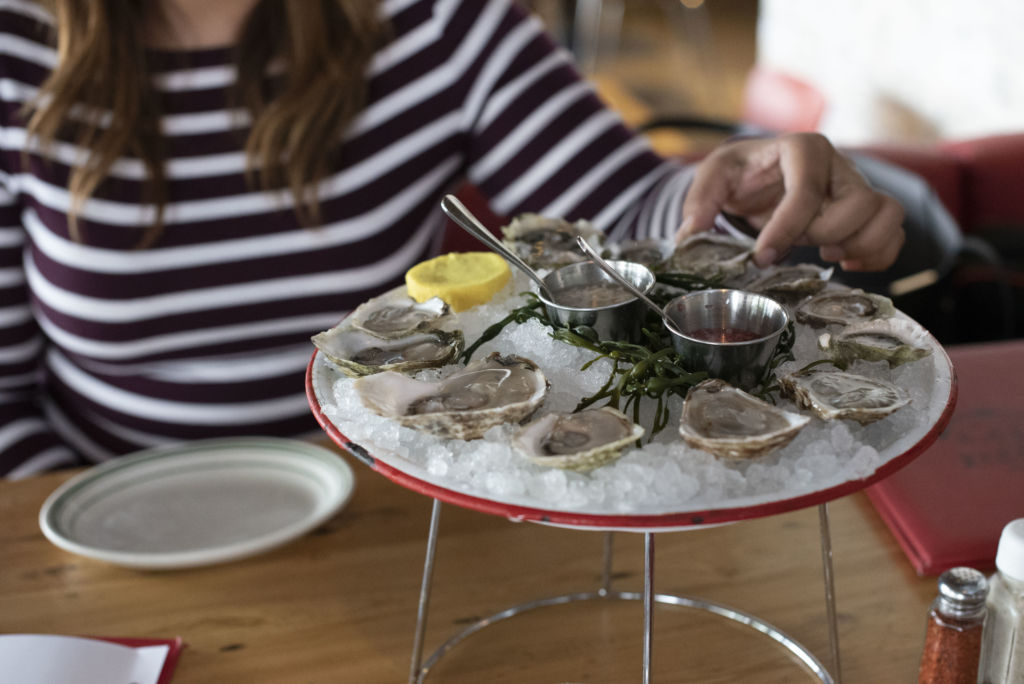Oysters 101
Where to Find the Best Oysters in West Hollywood
December 12, 2018 — 4 Minute Read
Icy cold, pristine and brimming with sublime flavor, raw oysters signal a celebration. This is the best time of year to eat these briny bivalves, especially when paired with champagne.
“Oysters are different from most food that Americans eat,” says expert and author Rowan Jacobsen of The Oyster Guide. “You’re eating a wild food and there’s a lot of life in there. You connect with the coast in such a direct, experiential way.”
And unlike rich or heavy holiday food that’s loaded with calories, oysters are low in fat and packed with nutrients. This is guilt-free feasting!
But it can be a bit confusing to know exactly what you’re ordering, so here’s a guide to get you started in West Hollywood.
To find your favorites, you’ll probably need to have a few separate tastings. “There are subtle but detectable differences in the flavors of oysters,” says Alyssa Shepherd, a manager at Connie & Ted’s. “Both the water an oyster is grown in and the species of oyster have a role to play in determining the flavor profile.”

The restaurant has a special cooler that uses coils (not fans) to keep oysters ocean-fresh. When they arrive, the oysters are checked for quality, tasted by a sous chef and shucked to order.
East Coast vs. West Coast
There are only five species of oysters that we eat, but varieties abound. Most of the oysters served in restaurants are Eastern (Crassostrea Virginica), Pacific (Crassostrea Gigas) and Kumamoto (Crassostrea Sikamea).
“West Coast oysters tend to be sweeter and crisper while East Coast oysters tend to have more brine and meatiness,” says Catch LA Executive Chef, Danny Ye. “Currently, from the West Coast, we are bringing in Kumamoto, Kusshi and Kumiai.
“Kumamoto and Kusshi are sweet and crisp, whereas Kumiai (from Baja California) are also crisp and sweet, but have a distinct brininess. From the East Coast, we are bringing in Malpeque, Beausoleil and Wianno.”
Catch usually has six varieties on the menu (market price).
Less commonly served in the U.S. is the European Flat (Ostrea Edulis). The most famous is Belon, named after the French river. Generally speaking, they are an acquired taste because of their coppery flavor. Those sourced from Maine taste quite different than their French counterparts. The Olympia (Ostrea Lurida), small with big taste, is the only oyster that’s native to America’s West Coast.
Serving in style
No matter which ones you choose, raw oysters should be freshly shucked and served on ice. Be sure they smell fresh and have plenty of “liquor” or natural juice. Never eat an oyster that looks dry. Sip the juice, chew the oyster and swallow. Put the shell back on the platter, round side up.
Specializing in West Coast oysters is Cavatina restaurant at the Sunset Marquis Hotel. While relaxing in an elegant, Mediterranean-inspired setting, you can order a half dozen, with mignonette sauce.
Ready for a little glitz? Get a half dozen on the half shell at BOA Steakhouse on the Sunset Strip.
Employees Only LA, a stylish update on a vintage speakeasy, offers raw oysters by the half dozen.
